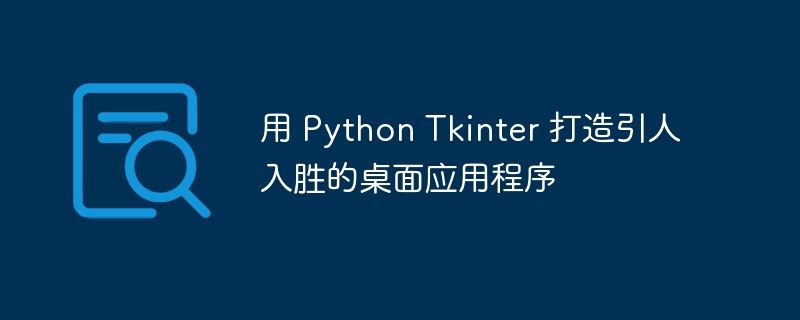Home >Backend Development >Python Tutorial >Build engaging desktop applications with Python Tkinter
Build engaging desktop applications with Python Tkinter
- WBOYWBOYWBOYWBOYWBOYWBOYWBOYWBOYWBOYWBOYWBOYWBOYWBforward
- 2024-03-24 09:40:101408browse

1. Responsive design
Tkinter applications can respond to different screen sizes and resolutions. By using grid and wrap layout managers, you can create applications that automatically resize to fit a variety of devices. This ensures your app has the best visuals on any platform.
2. Rich control collection
Tkinter provides an extensive collection of controls, including buttons, labels, text boxes, sliders, and menus. These controls are highly customizable, allowing you to design a custom interface based on your application's specific needs. By combining various controls, you can create complex and user-friendly applications.
3. Event handling
Tkinter enables you to handle various user events such as clicks, typing, and mouse movements. By defining callback functions, you can respond to user interaction and update your application as needed. This event-driven architecture allows you to create dynamic and interactive interfaces.
4. Data binding
Tkinter supports data binding, allowing you to link data in your application with GUI controls. When the data is updated, the control automatically updates, and changes in the control are reflected in the data. This simplifies application development, eliminating the need to manually update data and controls.
5. ThemingTkinter provides a built-in theme engine that allows you to customize the appearance of your application. You can create a custom theme or use a ready-made theme so that the application matches your brand or specific application needs. Theming features give your application a unique look and feel.
6. Cross-platform compatibilityThe Tkinter program runs on multiple platforms including
windows, MacOS and linux. This allows you to develop applications for different operating systems using the same code base, saving development time and effort.
7. Integrate other librariesTkinter can seamlessly integrate other
pythonlibraries such as NumPy, matplotlib and OpenCV. This provides the ability to build scientific and data visualization applications, image manipulation programs, and other applications that require specific functionality.
8. Extensibility and scalabilityTkinter applications can be easily extended and expanded to meet changing needs. You can create custom classes and functions to add new functionality or modify existing functionality, allowing your application to grow as your needs grow.
9. Rich online resourcesPython
The Tkinter community is large and active, offering a wide range of online resources. You can find support and help in the documentation, forums and tutorials to make the development process easier.
10. Building the sample applicationHere are some examples of building engaging desktop applications using Python Tkinter:
- Text Editor: Create a text editor that supports syntax highlighting, autocomplete, and save/load functionality.
- Image viewer: Develop an image viewer that can browse, zoom and edit images, with basic image processing functions.
- Music Player: Build a music player with playlists, control bar and album cover art.
- Data visualization tools: Use Tkinter and matplotlib to create interactive data Visualization applications that can draw graphs, charts, and data.
- Games: Take advantage of Tkinter's controls and event handling to develop a variety of games, from simple board games to more complex adventure games.
The above is the detailed content of Build engaging desktop applications with Python Tkinter. For more information, please follow other related articles on the PHP Chinese website!

